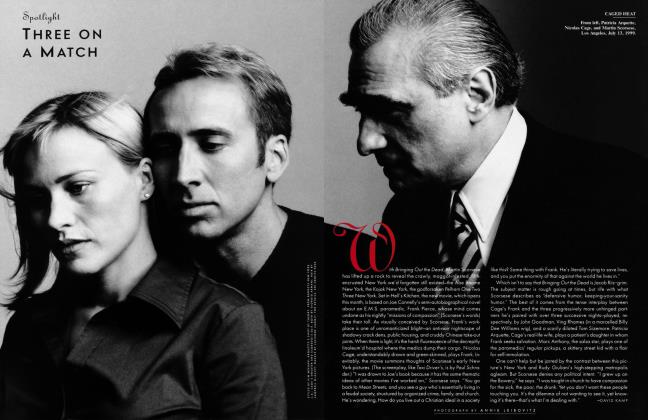Sign In to Your Account
Subscribers have complete access to the archive.
Sign In Not a Subscriber?Join NowTHE FOOD SNOB'S DICTIONARY VOL. 2
Flummoxed by menu descriptions of "dry-farmed" fruits, "grass-fed" beef, and "farmstead" blue cheese? Can't tell a Wagyu steak from a yuzu dipping sauce? Unsure if your kitchen is equipped with a chinois or a salamander, or why this would even be a good thing? Let Vanity Fair help you get your mise en place together with ...
DAVID KAMP
MARION ROSENFELD
Adria, Ferran. Catalonian chef of appropriately kooky, Dali-esque mien who functions as a lightning rod in the Food Snob debate over whether modern cooking is bracingly innovative or overwhelmed by gimmickry. The inventor of the vegetable foams and froths that reviewers loved in Spain in 1998 but condemn in America now, Adria, who operates out of a coastal resort-town restaurant called El Bulli (The Bulldog), combines an op-art aesthetic with a FERNAND POINT fealty to getting the most flavor out of his ingredients, resulting in such weird-ass but surprisingly edible creations as a red-mullet skeleton enshrouded in cotton candy and skinless green-pea ravioli that look like Dr. Seuss egg yolks. / clocked some Ferran Adria influence in those cold soups that the chef served in medical syringes.
Affinage. The process whereby young cheese is refined and matured, usually in a cave or climate-controlled chamber. The anointed cheese-coddler, known as an affineur, rotates the cheese and beats, brushes, and/or washes it until it is a point and ready to be savored. In the latest manifestation of cheesecourse mania, some American restaurateurs now employ their own affineurs, though no one has yet made the logical, inevitable step of marketing homeaffinage units in the vein of SUB-ZERO wine-storage units.
All-Clad. Pennsylvania-based cookware manufacturer whose signature stainless-steel pots and pans have long been fetishized by Food Snobs for their durability, excellent heat conductivity, elongated "stay-cool" handles, and aesthetic appeal. The five-piece All-Clad starter set is a staple of wedding registries in such Snob strongholds as New York and San Francisco.
Beebe, Lucius. Poncey, immaculately turned-out American society writer and gourmand of the screwball-comedy era, best known for his florid New York Herald Tribune columns of the 1930s and 40s, in which he recounted his social adventures as a walker par excellence and his elaborate feasts at gouty Gilded Age-throwback hotel dining rooms. Though verbose to the point of
[NOTE: Cross-references within the dictionary are spelled out in CAPITAL LETTERS. References to items in Volume I of the dictionary appear in RED CAPITAL LETTERS.]
lunacy ("The good life continues unabated in Hollywood even as in the days of hammered silver handset telephones and the first fine floodtide of early Ordovician Goldwynisms"), Beebe was one of the first name writers to take fine dining seriously as a subject, earning him the grudging respect of Snobs.
Brillat-Savarin, .Jcan-Anthelme. Worldly French lawyerstatesman (1755-1826) whose obsessive interest in eating well compelled him to write the Snob urtext The Physiology of Taste, a book that, in its fusing of recipes with personal memoir and witty gastronomical musings, anticipated by more than a century the works of M. F. K. FISHER (whose English translation of Brillat-Savarin's book is considered definitive). Brillat-Savarin is oft credited with the aphorism "You are what you eat," though what he actually wrote is the more socially trenchant "Tell me what you eat, and 1 shall tell you what you are." So revered is Brillat-Savarin in France that an especially vascular-plaque-generating Norman triple-creme cheese has been named after him.
Cepe. Cloying French synonym for porcini mushroom, used on menus to confuse diners who think porcinis are old news. Truly pretentious chefs use the term "boletus mushrooms" for cepes/porcinis, a shorthand allusion to the fungus's Latin name, Boletus edulis.
Chinois. Cone-shaped strainer with ultra-fine mesh or perforations; considered essential to serious chefs when making purer-than-pure stocks and fruit COULIS. The strainer gets its name, charmingly enough, from its resemblance to a Chinese coolie hat. Chef ripped me a new one for the flecks in the consomme; I should have run it through the chinois one more time.
Cocoa nibs. Smashed-up, unsugared pieces of roasted, husked cocoa beans; newly ubiquitous as a dessert garnish and ingredient. Pastry Snobs, who consider gooey "death by chocolate"-style desserts to be oversweet atrocities, prefer cocoa nibs to chocolate chips as a texture enhancer in cookies and ice creams.
Compost tea. Organic potion, heavily championed by the SUSTAINABLE AGRICULTURE crowd, that's made by adding water to compost, letting the mixture steep and ferment, and straining out the liquid, which is then sprayed on crops or poured into soil. A well-made compost tea, which can use anything from molasses to fish scraps as a food source for beneficial micro-organisms, works as both a pesticide substitute, keeping deadly plant diseases at bay, and as an enhancer of flavor and fertility for fruit and vegetable crops. All it took was a few gallons of compost tea, and voila!— my orchards were free of apple scab.
Coulis. A strained puree or cooked sauce of thin consistency. Though most coulis are associated with desserts (e.g., rhubarb-vanilla gelato with raspberry coulis), restive chefs are now making coulis out of everything they can think of, from uni (sea urchin) to CEPES.
Curnonsky. Pen name of Maurice Edmond Sailland (1872-1956), the premier French food writer of his time, known in Paris as the "prince of gastronomes." A sort of proto-James Beard, with his regal presence and hulking figure ("not dissimilar to an unfinished tub of butter"—Gertrude Stein), Curnonsky invented the concept of foodie-as-celebrity, referring to himself in the third person and causing gasps of thrilled recognition wherever he dined. Morbidly obese at the end of his life, he died when, one summer day, he leaned too far out a window, tipped over, and landed with a splat on the street below.
Dry-farmed. Adjective applied to fruit crops planted in spring, while the ground is still damp, and seldom, if ever, watered until maturation—forcing the plants' taproots to seek out water from the earth rather than the sky, and resulting in fruits of vividly concentrated, rather than waterlogged, flavor. You can keep your fancy heirloom tomatoes; me, I'm a dry-farmed Early Girl person.
E. Dehillerin. Ancient, family-run cookware store in Paris's First Arrondissement; a mecca for American Food Snobs even though electronic shopping and the metastasization of Williams-Sonoma has undercut the uniqueness of the shop's inventory. We couldn't help but make a pilgrimage to E. Dehillerin, scanning its overburdened shelves and racks in search of the copper-lined turbot kettle of our dreams.
Fair trade. Designation applied to imported foodstuffs whose producers, often ARI ISANAL craftsmen or farmers of modest means, have been paid an appropriate wage and have been treated nicely by American buyers rather than exploited as the food-world equivalent of sweatshop labor. The "fair trade" designation is especially popular among upmarket coffee retailers, who are conscious of the fact that their beans come from developing nations with suspect human-rights records, and who therefore assume that their affluent customers won't mind paying a premium for getting their caffeine buzz without underwriting the flaying of poor thirdworld workers.
Farmstead. Lyrical adjective used to describe foodstuffs, usually cheeses, made on-site at the very farm where the dairy animals are kept and milked (or, in the case of farmstead baked goods and preserves, where the pertinent crops are grown). The ARI ISANAl nature of farmstead cheeses, along with their elimination of a link in the farm-to-table chain of production, has made them a cause celebre in SLOW I OOI> circles. Alice welcomed us with a simple snack of farmstead cheddar, apple slices, and walnut-raisin bread. Perfect!
Fleur de sel. Expensive French sea salt of labor-intensive provenance. Handgathered in the summertime by paludiers (artisan harvesters) near the Breton town of Guerande, fleur de sel is gently raked from only the top crust of the salt beds (traditionalists prefer female paludieres, who purportedly have a lighter hand), and the loosened crystals are bagged and sent to market. Snobs aver that fleur de sel is always to be used as a condiment, adding flavor and textural crunch to finished dishes, rather than as a seasoning in cookery, where it dissolves and its special qualities are lost. I ate the purslane salad with just a pinch of fleur de sel and a drizzle of McEvoy Extra Virgin—the essence of simplicity.
Forcemeat. Snicker-inducingly named standby of haute cuisine. A mixture of finely ground meat (beef, poultry, or fish) held together by a binding agent (eggs, breadcrumbs, etc.) and carefully seasoned, forcemeat can be used as a stuffing or as a dish in its own right, as when it's shaped into quenelles or a terrine. The quest to make perfect forcemeat was a central plot element of Michael Ruhlman's rhapsodic Snob-lit classic, The Soul of a Chef.
Grass-fed beef. Beef from cattle who have been allowed to roam and graze in pastureland rather than mill about in pens, awash in their own filth and fed a species-inappropriate diet of grain and drugs; the rare menu qualifier (see also DAYHOAJ and FARMSTEAD) that has actual nutritional import. The argument for grassfed beef is that it's not only better for the welfare of the animals, who, as ruminants, are not equipped with the appropriate enzymes and bacteria to fully digest grain, but also better for human consumers, since the beef is lower in "bad" fats and higher in "good fats than normal beef, and it's not loaded with the antibiotics that evil agribusiness ranchers shoot up their livestock with in order to overcome the liver abscesses the cattle develop from trying to digest grain.
Hudson Valley Foie Gras. Upstate New York pioneer in the U.S. manufacture of the traditionally French-made fattened-liver treat. Made not from goose livers but from those of the Moulard duck (a hybrid of the Muscovy and Pekin breeds), Hudson Valley Foie Gras, since its founding in 1989, has become a staple of regionally minded East Coast restaurants and posh food stores nationwide. Next up on the tasting menu was a slab of seared Hudson Valley Foie Gras in elderberry sauce, its membranous outside quickly giving way to a velvety ooze.
Mise en place. Fancy French term for doing all one's food prep before actually cooking—chopping, measuring, arranging, cleaning up, and so on. Especially Snobworthy when shortened to "meez" and used as a verb. Honey, I've meezed everything for Julia's supremes de volaille a blanc; now all we need is for our guests to arrive.
P.E.I. mussels. Distinctively briny shellfish from Prince Edward Island, in Canada; the island's second-most-famous export after Anne of Green Gables. With the possible exceptions of Olympia oysters (Pacific Northwest) and Nantucket bay scallops (Massachusetts), no other North American bivalve mollusk gets such play on fine-dining menus. Chef Moonen got us off to a rollicking start with P.E.I. mussels in a piquant, lemongrass-infused Thai broth.
Quinoa. Baffling fixture of chic menus (pronouncedKeen-wafo)that, though it sounds like a Japanese management concept, is actually an ancient Incan grainlike substance whose popularity has been revived by vegan zealots and RAW FOOD-ists, who uphold it as an ideal protein-and-fiber source, and also by modern chefs, who put it on plates when they feel like serving an "interesting" starch instead of rice or couscous. Technically, though, quinoa is not a grain but the seed of a leafy plant related to chard.
Raw food. Bonkers, militant movement that uses a sensible premise—that lots of ingredients taste better and provide more nutrition in their uncooked state, and that the techniques of heatless food preparation are underexplored by American chefs—as a launchpad for an absolutist argument that cooking is the enemy of life, because heating food above 118 degrees destroys not only nutrients but the enzymes that aid proper digestion, resulting in ulcers, arteriosclerosis, and other horrors. That most people willingly eat foods they know not to be 100 percent healthful in the pursuit of pleasure—the ultimate goal of cookery—seems utterly lost on ascetic rawfoodists, though it must be said that the movement's high priestess, the glowing, replicant-like Roxanne Klein (of Roxanne's To Go, the retail outlet of her now-shuttered Marin County restaurant), makes a good faux pad Thai with coconut strands substituting for noodles.
Root, Waverly. Preciously named food historian (1903-82) who cut his teeth as a Paris-based reporter for the Chicago Tribune in the 1920s, befriending that era's Lost Generation coterie of expat American bohemians and falling in love with French cuisine. Increasingly preoccupied with eating as well as possible, Root became the prototypical genially overstuffed overseas correspondent, setting the stage for The New Yorker's. A. J. Liebling (who, though a contemporary of Root's, settled in Paris later) and The New York Times's R. W. "Johnny" Apple. Root's travelogue/ culinary guide The Food of France (1958) was the essential text for American food tourists in the 60s.
Salamander. Squat, wide broiler beloved by professional chefs for its space efficiency and intense generation of heat, which cuts down on cooking times and is useful for finishing off dishes that require browning and crisping. We pulled the brulees out of the oven and threw 'em in the salamander to caramelize the tops.
Silpat. Re-usable silicone cooking sheet that, when placed on a counter or in a baking sheet, provides an ideal nonstick surface on which to roll out dough or bake confections; favored by home bakers and professionals over parchment paper, which, though more traditionalist, clings maddeningly to everything. Ever since I switched over to Silpats, my tuiles are more beautiful than ever.
Sontheimer, Carl. M.I.T.-trained engineer and compulsive tinkerer (1914-98) whose love of cooking and eating resulted, after a prosperous career in electronics, in a second act as the inventor of the Cuisinart food processor (which was actually a licensed, modified version of an industrial blender he found in France, Le Magimix). Though perceived as a dubious fad gadget upon its introduction in the early 1970s, the Cuisinart took off when the media-savvy Sontheimer demo'd his gizmo for Julia Child and James Beard, who pronounced it nothing less than a seismic development in the annals of home cookery. Thus did Cuisinarts become the coveted objects of elbows-out department-store wrangles in the mid-70s, and did Sontheimer come to enjoy an odd sort of kitchen-implement celebrity not repeated until George Foreman came along.
Stone fruit. The large-pitted fruits of the Prunus genus, among them peaches, plums, nectarines, apricots, and cherries; exalted by Fruit Snobs for their sensual juiciness and delicacy as compared to hardier fruits like apples and pears. The received Snob wisdom is that most Americans have never properly experienced stone fruits in their ideal ungassed, unshipped, unhybridized state, in which they are so succulent and dribbly that eating them qualifies as an erotic experience. In the tumid fullness of the August night, we feasted on just-picked white peaches, the most luscious of stone fruits, their effluvia streaming down our heaving, perspiring chests.
Wagyu. Marketing term for richly marbled beef that comes from the same cattle as Kobe beef but costs somewhat less. Though both Kobe and Wagyu beef come from the Wagyu bull (the word "Wagyu" simply means "Japanese cattle"), Kobe beef must come from cattle actually raised in Kobe, in accordance with severe, A (X -like production strictures, whereas Wagyu beef can come from cattle raised in the United States. Snobs, though they consider certified Kobe beef a vulgar folly for expenseaccount schmucks, are disposed kindly toward Wagyu, and are keen to flaunt their knowledge that the beef is best served Japanese-style—sliced thinly and either quickly seared or served raw, sashimi-style—rather than cooked as a slab in the broiler.
Yuzu. Japanese citrus fruit prized for its highly aromatic rind. Traditionally used in dipping sauces for dumplings and spring rolls, yuzu is now being abused willy-nilly by Western chefs in their fusion experiments—though the fruit has already lost some of its Snob cachet now that it is an ingredient in an aromatherapy body wash for sale on QVC.
 View Full Issue
View Full Issue












Subscribers have complete access to the archive.
Sign In Not a Subscriber?Join Now